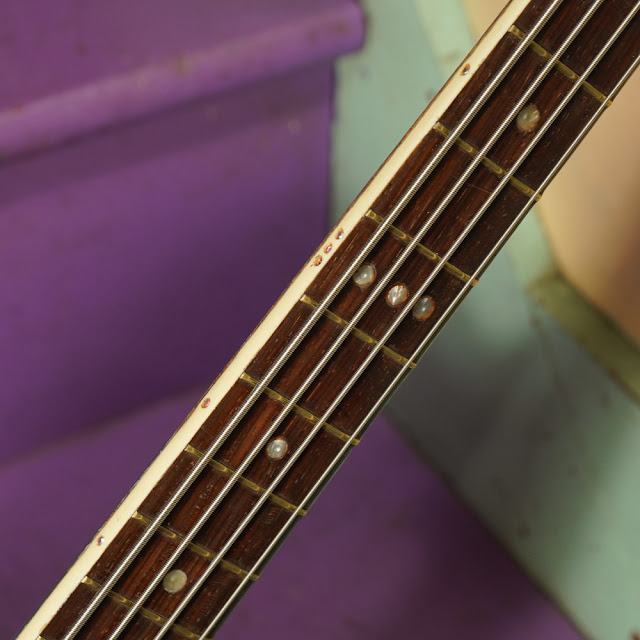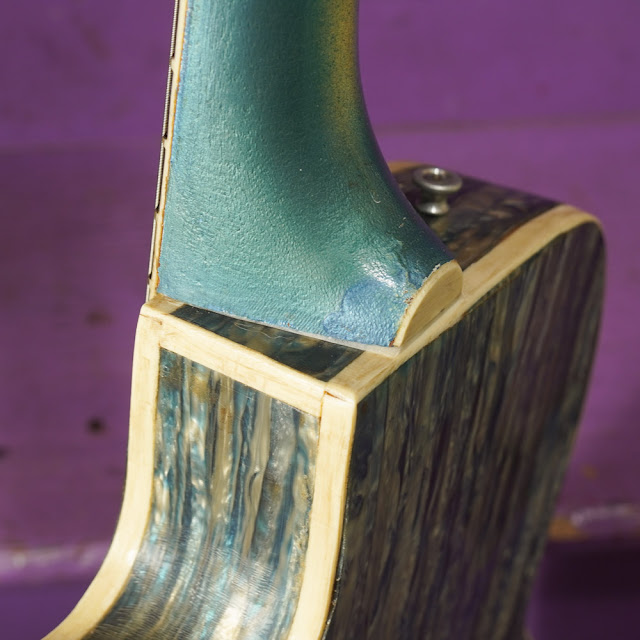1960s East German Electric Rubber Bridge Bass Conversion
Overview: I'm pretty sure this started-out as an East German archtop electric guitar from the '60s. It has a weird Slingerland logo inside of one of the f-holes and certainly looks like it's wrapped in "sky blue pearl" drum-wrap, so perhaps there's a connection there but the logo looks wrong -- as if it's been cut and pasted in from something other than a manufacturer's label. It arrived with a National(!) tailpiece and modern ABR bridge installed plus an old DeArmond pickup. It was not really a "working guitar" as-is and, because it's so damn cool and also because it has the weirdest bevel for the "high E string" part of the fretboard, I immediately singled it out to be a rubber-bridge bass candidate. Jose did all the conversion work and it's come out the other side a winner.
Interesting features: There's so much to like -- from the metallic-blue-sunburst-finished rear of the neck to the warped celluloid wrap all over the whole instrument giving it quirky curves and styling. The pickguard is truly something to behold -- it houses the wiring and jack and is fit as a wedge over the top with curved, molded edges and a recessed trim line -- it's so cool! The whole thing is bound. It has a rosewood fretboard with faux-pearl dots and then someone went and added rhinestones for side dots. The high-E portion of the fretboard rounds-over a lot and I recall reading some bad advertisement from period sources about this being some sort of "speed feature" as it relates to guitar. In this instance, the strings do not pass over that section, so it only serves to look cool. The tuners are parts-bin specials and have pearl-like buttons to match the rest of the trim. It, of course, has been modified to serve as a 4-string bass and has our now-standard rubber-saddle setup for these -- the rubber sits on a steel bar which then sits on adjuster posts for easy action adjustment. We reused an old Strat claw as a tailpiece. Yip!
Repairs included: Jose converted it over, rewired it, gave it a level/dress of the frets, and set it all up and cleaned it. I added a hidden bolt internally to reinforce the neck joint as we didn't do a reset on it (the angle was good). It's playing fast and spot on and is ready to go.
- Weight: 5 lbs 10 oz
- Scale length: 24 1/8"
- Nut width: 1 1/2"
- Neck shape: slim-medium C
- Board radius: flat save for curved treble edge
- Depth at first fret: 27/32"
- Depth at seventh fret: 15/16"
- Body width: 14 3/8"
- Body depth: 2 1/8"
- Body wood: ply of some sort w/celluloid veneer
- Bridge: rubber saddle on steel, adjustable height
- Fretboard: rosewood
- Neck wood: poplar or maple, presumably
- Pickups: 1x humbucker lipstick pickup
- Action height at 12th fret: 3/32" bass to 1/16" treble (fast, spot-on)
- String gauges: 95w-40w
- Truss rod: non-adjustable
- Neck relief: straight
- Fret style: medium/lower
Condition notes: I mean -- it has some stuff going on. The celluloid has warped as it's aged, causing the surface to curve-up at the f-holes (you can see it in the pics). The celluloid has also pulled at the edges of the top and back, so while the top and back seams are all good to go, there are areas where it's got irregular surface veneer height. The tuners, strap buttons, and added pearl dots in the headstock veneer and pickguard are not original. The tailpiece, bridge, pickup, and wiring harness are not original. It has some mild usewear throughout, too.
It comes with: It has a gigbag of some sort.
Consignor tag: DVCH






























Comments